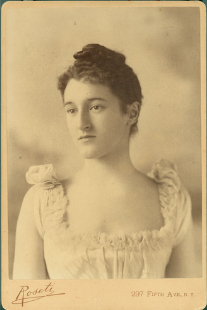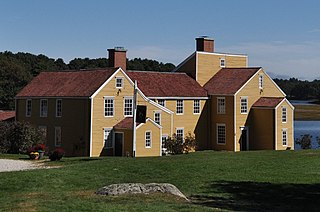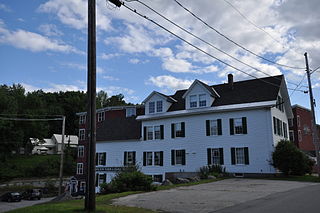
Beatrix Cadwalader Farrand was an American landscape gardener and landscape architect. Her career included commissions to design about 110 gardens for private residences, estates and country homes, public parks, botanic gardens, college campuses, and the White House. Only a few of her major works survive: Dumbarton Oaks in Washington, D.C., the Abby Aldrich Rockefeller Garden on Mount Desert, Maine, the restored Farm House Garden in Bar Harbor, the Peggy Rockefeller Rose Garden at the New York Botanical Garden, and elements of the campuses of Princeton, Yale, and Occidental.
Bar Harbor is a resort town on Mount Desert Island in Hancock County, Maine, United States. As of the 2020 census, its population is 5,089. The town is home to the College of the Atlantic, Jackson Laboratory, and MDI Biological Laboratory. During the summer and fall seasons, it is a popular tourist destination.

Mount Desert Island in Hancock County, Maine, is the largest island off the coast of Maine. With an area of 108 square miles (280 km2) it is the 52nd-largest island in the United States, the sixth-largest island in the contiguous United States, and the second-largest island on the Eastern Seaboard, behind Long Island and ahead of Martha's Vineyard. According to the 2010 census, the island has a year-round population of 10,615. In 2017, an estimated 3.5 million tourists visited Acadia National Park on MDI. The island is home to numerous well-known summer colonies such as Northeast Harbor and Bar Harbor.
An estate is a large parcel of land under single ownership, which would historically generate income for its owner.

The Mount (1902) is a country house in Lenox, Massachusetts, the home of noted American author Edith Wharton, who designed the house and its grounds and considered it her "first real home." The estate, located in The Berkshires, is open to the public. The property was declared a National Historic Landmark in 1971.

Max Farrand was an American historian who taught at several universities and was the first director of the Huntington Library.

Hill–Stead Museum is a Colonial Revival house and art museum set on a large estate at 35 Mountain Road in Farmington, Connecticut. It is best known for its French Impressionist masterpieces, architecture, and stately grounds. The property was designated a National Historic Landmark as a nationally significant example of Colonial Revival architecture, built in 1901 to designs that were the result of a unique collaboration between Theodate Pope Riddle, one of the United States' first female architects, and the renowned firm of McKim, Mead & White. The house was built for Riddle's father, Alfred Atmore Pope, and the art collection it houses was collected by Pope and Riddle.

Steepletop, also known as the Edna St. Vincent Millay House, was the farmhouse home of Pulitzer Prize-winning poet Edna St. Vincent Millay and her husband Eugen Jan Boissevain, in Austerlitz, New York, United States. Her former home and gardens are maintained by the Edna St. Vincent Millay Society, a nonprofit organization that also holds the rights to the poet's intellectual property. Steepletop was declared a National Historic Landmark on November 11, 1971.

Wentworth–Coolidge Mansion is a 40-room clapboard house which was built as the home, offices and working farm of colonial Governor Benning Wentworth of New Hampshire. It is located on the water at 375 Little Harbor Road, about two miles southeast of the center of Portsmouth. It is one of the few royal governors' residences to survive almost unchanged. The site is a New Hampshire state park, declared a National Historic Landmark in 1968. Today, the New Hampshire Bureau of Historic Sites manages the site with the assistance of the Wentworth-Coolidge Commission, a group of volunteer civic and business leaders appointed by the Governor.
Reef Point Estate was located in Bar Harbor, Maine, United States, on Mount Desert Island. Reef Point was the coastal “cottage” of Mary Cadwalder Rawle and Frederic Rhinelander Jones, the parents of landscape architect, Beatrix Farrand (1872–1959). It stood beside Bar Harbor's Shore Path.

The Bass Boarding House is an historic house on Canal Street in Wilton, Maine, United States. It was built in 1860s, and adapted for use as worker housing for G.H. Bass & Co., whose former factory building stands next door. The building, one of a few that survive in Wilton that were adapted in this way, was added to the National Register of Historic Places in 1988. It now houses the Wilton Historical Society's Wilton Farm and Home Museum.

The Asticou Azalea Garden in Northeast Harbor, Maine, United States, is a popular visitor attraction. It was created by lifelong resident of the village, Charles Kenneth Savage, in 1956. Much of the initial plant collection originated at Reef Point Estate in nearby Bar Harbor, the summer residence of renowned landscape architect Beatrix Farrand. The collection was moved with the financial assistance of John D. Rockefeller Jr., including the weeping hemlock, just north of the main bridge.
The Cover Farm is an historic farmstead on Maine State Route 3 in the Hulls Cove village of Bar Harbor, Maine on Mount Desert Island. Its centerpiece is an early 19th-century Cape, set on a parcel of land owned until 1810 by the granddaughter of the island's original French proprietor, Antoine de la Mothe Cadillac. In the early 20th century, the property was transformed into a summer estate, with the addition of a Colonial Revival wing and a walled garden. The property was listed on the National Register of Historic Places in 1995.
The Farm House is a historic summer estate at 15 Highbrook Road in Bar Harbor, Maine. The estate includes a 19th-century farmhouse which was extensively altered in the 1920s to Colonial Revival designs by Arthur McFarland, who also designed a caretaker's cottage on the property. The property also includes a series of garden spaces designed by Beatrix Farrand. This work was done for Mildred McCormick, an heir to the fortune of Cyrus McCormick, inventor of the combine harvester. The estate was listed on the National Register of Historic Places in 2007.

Mary Rutherfurd Jay (1872–1953) was one of America's earliest landscape architects and an advocate of horticultural education and careers for women. The great-great granddaughter of American Founding Father John Jay, she grew up in Rye, New York surrounded by the gardens of her ancestral homestead at the Jay Estate in Westchester County overlooking Long Island Sound. Her education was fostered by travel abroad with her mother and domestically through classes in design and horticulture taken at the Massachusetts Institute of Technology (MIT) and the Bussey Institute in Forest Hills, Massachusetts.
Brave Boat Harbor Farm is a historic gentleman's farm at 110 Raynes Neck Road on the coast of York, Maine, United States. Developed in the early 1950s, it consists of a designed horticultural landscape with five structures, the most significant being a Colonial Revival house built at that time. The property was listed on the National Register of Historic Places in 2007.

Rock Rest is a historic house and African-American traveler's accommodation at 167 Brave Boat Harbor Road in Kittery, Maine. The property was operated as a summer guest house by Clayton and Hazel Sinclair between 1946 and 1977, and is one of the few known places in Maine that explicitly welcomed African-American guests in an era when racial discrimination in public accommodations was common. The property was listed on the National Register of Historic Places in 2008.

The Pettengill House and Farm is a historic conservation property in Freeport, Maine, United States. Now owned by the Freeport Historical Society, this farm was in active use from at least 1831 until 1960. More than 140 acres (57 ha) of its original 180 acres (73 ha) have been preserved, as has the c. 1800 saltbox farmhouse. The property was listed on the National Register of Historic Places in 1970, and is part of the 1974 Harraseeket Historic District. The farm is located at the southern end of Pettengill Road in Freeport's Mast Landing area. The house faces south, looking down the Harraseeket River. The property's trails are open to the public daily from dawn to dusk.

Mary Cadwalader Rawle Jones was an American author, socialite, and social leader during the Gilded Age.

Thuya Garden is a semi-formal herbaceous garden, in the style of Gertrude Jekyll, located at 15 Thuya Drive, Northeast Harbor, Maine. It is open daily from May through October.















